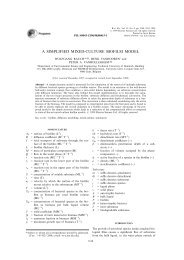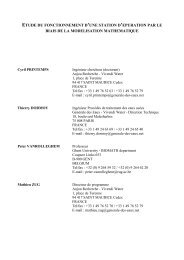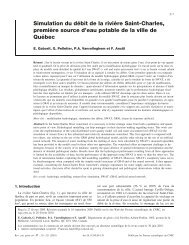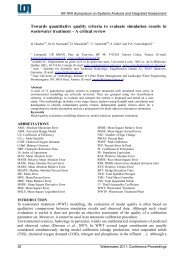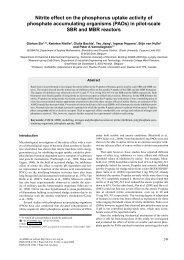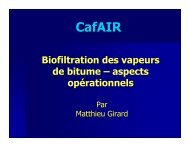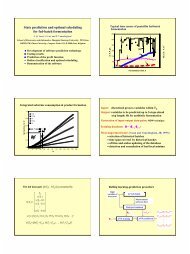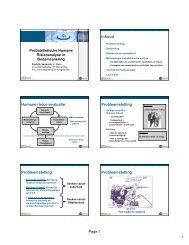Modeling 17α-ethinylestradiol removal in membrane bioreactors
Modeling 17α-ethinylestradiol removal in membrane bioreactors
Modeling 17α-ethinylestradiol removal in membrane bioreactors
Create successful ePaper yourself
Turn your PDF publications into a flip-book with our unique Google optimized e-Paper software.
Clouzot et al.<br />
<strong>Model<strong>in</strong>g</strong> <strong>17α</strong>-<strong>eth<strong>in</strong>ylestradiol</strong> <strong>removal</strong> <strong>in</strong> <strong>membrane</strong><br />
<strong>bioreactors</strong><br />
Ludiw<strong>in</strong>e Clouzot 1-2 , Frédéric Cloutier 1 and Peter A. Vanrolleghem 1<br />
1 modelEAU, Département de génie civil et de génie des eaux, Université Laval, 1065 avenue de la médec<strong>in</strong>e, G1V<br />
0A6 Québec, Québec, Canada (Emails: ludiw<strong>in</strong>e.clouzot.1@ulaval.ca; frederic.cloutier.1@ulaval.ca;<br />
peter.vanrolleghem@gci.ulaval.ca)<br />
2 Laboratoire de Mécanique, Modélisation et Procédés Propres (M2P2-CNRS-UMR6181), Université Paul Cézanne<br />
d’Aix Marseille, Europôle de l’Arbois, BP 80, Bat. Laennec, Hall C, 13 545 Aix en Provence Cedex 04, France.<br />
Abstract<br />
The aim of this work was to develop a model that describes the fate of the synthetic hormone <strong>17α</strong><strong>eth<strong>in</strong>ylestradiol</strong><br />
(EE2) <strong>in</strong> a <strong>membrane</strong> bioreactor (MBR) process. Results from the modeled<br />
experimental data show that sorption is the ma<strong>in</strong> <strong>removal</strong> mechanism dur<strong>in</strong>g the first 10 days of<br />
exposure to EE2, but the <strong>removal</strong> efficiency drops from 97% to 28% as sorptive capacity saturates.<br />
Then, as the biomass slowly (over a period of 10 days) adapts to the presence of EE2, the <strong>removal</strong><br />
<strong>in</strong>creases aga<strong>in</strong> to 68%. The proposed model considers co-metabolism on soluble EE2 dur<strong>in</strong>g the<br />
aerobic growth of nitrify<strong>in</strong>g bacteria with a logistic function to describe the adaptation period. This<br />
structure is able to represent the observed behaviour of EE2 <strong>in</strong> the studied MBR process.<br />
Keywords<br />
Acclimation; Activated Sludge Model; Co-metabolism; MBR; <strong>Model<strong>in</strong>g</strong>, Emerg<strong>in</strong>g contam<strong>in</strong>ants,<br />
Endocr<strong>in</strong>e disruptors<br />
INTRODUCTION<br />
Conventional activated sludge (CAS) is a widely used bioprocess to treat municipal wastewaters.<br />
With the addition of <strong>membrane</strong> filtration, <strong>membrane</strong> <strong>bioreactors</strong> (MBRs) offer the benefit of<br />
constant effluent quality <strong>in</strong> terms of total suspended solids (TSS) and the high sludge retention time<br />
(SRT) characteristic of MBRs leads to a more diversified and efficient biomass. Activated sludge<br />
models (ASM) are well established for the eng<strong>in</strong>eer<strong>in</strong>g design practice of the wastewater <strong>in</strong>dustry.<br />
While these models were orig<strong>in</strong>ally developed for CAS systems they are now more and more<br />
applied to MBR processes (Fenu et al., 2010). However, key factors still need further <strong>in</strong>vestigation.<br />
Literature <strong>in</strong>dicates that wastewater discharges <strong>in</strong> receiv<strong>in</strong>g waters contribute significantly to the<br />
presence of contam<strong>in</strong>ants of emerg<strong>in</strong>g <strong>in</strong>terest <strong>in</strong> sources of dr<strong>in</strong>k<strong>in</strong>g water (Benotti et al., 2009).<br />
For this purpose, dynamic models of the fate of micropollutants <strong>in</strong> wastewater systems were<br />
developed dur<strong>in</strong>g the SCORE-PP project (Source Control Options for Reduc<strong>in</strong>g Emissions of<br />
Priority Pollutants, www.scorepp.eu). Although the CAS process was <strong>in</strong>cluded <strong>in</strong> the SCORE-PP<br />
project, noth<strong>in</strong>g was proposed for MBR systems. A dedicated literature review revealed various<br />
studies on <strong>removal</strong> of micropollutants <strong>in</strong> MBR (e.g. Sipma et al., 2010, Paetkau et al., 2011) but no<br />
paper has been found on model<strong>in</strong>g their fate. Therefore, the wastewater <strong>in</strong>dustry would benefit from<br />
the development of new models for the <strong>removal</strong> of these particular pollutants <strong>in</strong> MBR. The<br />
objective of the work was thus to develop an MBR model for emerg<strong>in</strong>g contam<strong>in</strong>ants.<br />
The synthetic hormone <strong>17α</strong>-<strong>eth<strong>in</strong>ylestradiol</strong> (EE2), widely used <strong>in</strong> human contraceptives, is an<br />
emerg<strong>in</strong>g contam<strong>in</strong>ant of great concern (Clouzot et al., 2008). EE2 was chosen because it is one of<br />
165
Poster Session<br />
WWTmod2012<br />
the most potent endocr<strong>in</strong>e disrupters and its environmental concentration is known to impact<br />
endocr<strong>in</strong>e system and reproductive functions of aquatic organisms, amphibians, birds and<br />
mammals. EE2 was shown to be primarily removed by sorption <strong>in</strong> CAS system (Andersen et al.,<br />
2005) because this synthetic hormone has a low biodegradability and a high hydrophobicity. EE2<br />
biodegradation has been ma<strong>in</strong>ly attributed to co-metabolism through the key enzyme of<br />
nitrification, the ammonium monooxygenase (AMO) (Yi and Harper, 2007). The long SRT applied<br />
<strong>in</strong> the MBR process supports the development of nitrify<strong>in</strong>g biomass and thus, is expected to<br />
improve EE2 <strong>removal</strong>.<br />
The first step of the study was to collect an extensive experimental data set on EE2 <strong>removal</strong> <strong>in</strong> a<br />
pilot-scale MBR operated under various conditions. Then, the experimental data were used to<br />
develop and calibrate the MBR model. The f<strong>in</strong>al objective was to apply the academic knowledge<br />
acquired for EE2 to the optimization of wastewater treatment plant (WWTP) design and operation.<br />
METHODS<br />
<strong>17α</strong>-<strong>eth<strong>in</strong>ylestradiol</strong><br />
The values of the partition coefficient of EE2, K D , <strong>in</strong> the literature range from 0.28 l/g (Gomes et<br />
al., 2011) to 1.0 l/g (Clara et al., 2004). Its octanol-water partition coefficient, K OW , varies between<br />
4677 l/g and 14125 l/g while its Henry’s law constant is 7.94 * 10 -12 atm.m³/mol (de Mes et al.,<br />
2005). Therefore, EE2 is assumed to be non-volatile and susceptible to sorption. Moreover, studies<br />
have shown that EE2 is slowly biodegradable under aerobic conditions when nitrify<strong>in</strong>g bacteria are<br />
present (Shi et al., 2004).<br />
Experimental data<br />
Activated sludge sampled from a full-scale CAS system was grown on a synthetic substrate (C/N/P:<br />
100/10/2) dur<strong>in</strong>g 83 days <strong>in</strong> a <strong>membrane</strong> bioreactor (MBR) consist<strong>in</strong>g of a reactor followed by an<br />
external <strong>membrane</strong> (Clouzot et al., 2010). Afterwards, EE2 was added <strong>in</strong> the <strong>in</strong>fluent at a constant<br />
concentration of 0.5 mg.L -1 dur<strong>in</strong>g 16 days. The hormone was quantified <strong>in</strong> the permeate to<br />
calculate its <strong>removal</strong>.<br />
The MBR was operated under different conditions to evaluate the effect on EE2 <strong>removal</strong> (Table 1).<br />
A hydraulic retention time (HRT) of 20h was first tested and then, a 7h-HRT was applied to<br />
simulate an overload of pollution. EE2 was removed from the <strong>in</strong>fluent between the two HRTexperiments.<br />
Dissolved oxygen was provided on a cyclic period to allow two hours of aerobic<br />
conditions followed by one hour of anoxic conditions.<br />
Table 1. Operat<strong>in</strong>g conditions of the different experimental phases<br />
Phase 1<br />
(2.4 days)<br />
Phase 2<br />
(4 days)<br />
Phase 3<br />
(8 days)<br />
HRT 20 h 20 h 7 h<br />
EE2 YES NO YES<br />
Substrate YES YES YES<br />
Oxygen YES YES YES<br />
166
Clouzot et al.<br />
<strong>Model<strong>in</strong>g</strong> approach<br />
<strong>Model<strong>in</strong>g</strong> was performed us<strong>in</strong>g the software WEST (www.mikebydhi.com). The pilot plant was<br />
represented by a s<strong>in</strong>gle MBR unit without any backwash<strong>in</strong>g system s<strong>in</strong>ce no <strong>membrane</strong> cleanup<br />
was performed dur<strong>in</strong>g the experiment. Moreover, no foul<strong>in</strong>g was observed dur<strong>in</strong>g the experiment,<br />
and thus, a simple MBR model that does not consider foul<strong>in</strong>g was chosen. A controller and a timer<br />
were used to simulate the cyclic aeration of the reactor and to ma<strong>in</strong>ta<strong>in</strong> the dissolved oxygen<br />
concentration between 0 and 3 mg/l.<br />
The fate of the traditional activated sludge components was described us<strong>in</strong>g the ASM1 model<br />
(Henze et al., 1987) (Table 2). The decay rates of autotrophic biomass (b A ) and heterotrophic<br />
biomass (b H ), the fraction of biomass converted to <strong>in</strong>ert matter (f P ) and the yield for autotrophic<br />
biomass (Y A ) determ<strong>in</strong>ed <strong>in</strong> the MBR experiments of Jiang et al. (2005) were selected. The default<br />
value of the maximum specific growth rates of autotrophic biomass (µ A ) and heterotrophic biomass<br />
(µ H ) at 20°C were chosen s<strong>in</strong>ce they allowed near-complete <strong>removal</strong> of soluble substrate and<br />
ammonia, as was observed dur<strong>in</strong>g the experiment. The yield for heterotrophic biomass (Y H ) was<br />
calibrated <strong>in</strong> order to obta<strong>in</strong> a suspended solids concentration of 13 g/l at steady state, a value that<br />
was rather constant throughout the experiment. The higher value selected for Y H can be expla<strong>in</strong>ed<br />
by the use of glucose as a carbon source, which has a higher yield than acetate and wastewater due<br />
to an enhanced storage metabolism (Dircks et al. 1999).<br />
Table 2. Calibrated values of the ASM1 k<strong>in</strong>etics parameters.<br />
Parameters ASM1 values Calibrated values Units References<br />
(20°C)<br />
b A 0.04 0.08 d -1 Jiang et al. (2005)<br />
b H 0.62 0.25 d -1 Jiang et al. (2005)<br />
f P 0.08 0.06 - Jiang et al. (2005)<br />
µ A 0.8 0.8 d -1 Henze et al. (1987)<br />
µ H 6.0 6.0 d -1 Henze et al. (1987)<br />
Y A 0.24 0.25 g COD /g N Jiang et al. (2005)<br />
Y H 0.67 0.7 g COD /g COD -<br />
RESULTS AND DISCUSSION<br />
The proposed add-<strong>in</strong> to the ASM1 (Henze et al, 1987) <strong>in</strong>cludes two additional components, soluble<br />
concentration of EE2, S EE2 (mg/l) and sorbed concentration of EE2, X EE2 (mg/l), and three<br />
additional processes, sorption/desorption of EE2 on TSS (mg TSS/l) and co-metabolic degradation<br />
of soluble EE2 by nitrify<strong>in</strong>g bacteria, X BA (mg COD/l) (Table 3).<br />
Sorption model<br />
The structure of the sorption/desorption processes mimics the one used by L<strong>in</strong>dblom et al. (2009)<br />
where sorption is described by a pseudo-first order reaction with a sorption rate k sor (l/mg.d), the<br />
TSS concentration and the concentration of soluble EE2. Desorption is proportional to the<br />
concentration of sorbed EE2 <strong>in</strong> a first order manner with a desorption rate k des (d -1 ). At steady-state,<br />
the ratio between the sorption rate and the desorption rate equals K D (l/mg), the partition<br />
coefficient. The data showed that sorption became limited as time went by and this was modeled by<br />
a saturation function similar to the one used <strong>in</strong> the hydrolysis k<strong>in</strong>etic function, but with a<br />
167
Poster Session<br />
WWTmod2012<br />
modification similar to the Hill k<strong>in</strong>etics, i.e. a power-law on the concentration. The parameter K EE2<br />
represents the maximum number of sorption sites that are available for sorption.<br />
Table 3. Gujer matrix of the add-<strong>in</strong> model describ<strong>in</strong>g EE2’s sorption and co-metabolic degradation<br />
Process S O S EE2 X EE2 X BA Process rate (g/m³.d)<br />
Sorption − 1 1<br />
Desorption 1 − 1<br />
Co-metabolic<br />
degradation<br />
by grow<strong>in</strong>g<br />
nitrifiers<br />
168<br />
− 1 1<br />
k<br />
⎛<br />
⎜<br />
EE 2<br />
EE2<br />
∗ X ∗S<br />
∗⎜<br />
⎟<br />
⎜<br />
EE 2<br />
n X<br />
EE 2 ⎛ ⎞ ⎟<br />
sor TSS EE2 n<br />
EE2<br />
⎜ KEE2<br />
+ ⎜ X ⎟<br />
TSS<br />
⎝<br />
k<br />
sor<br />
⋅ X<br />
K<br />
− ( )<br />
NH O EE2<br />
D<br />
EE2<br />
S S S<br />
η t ∗µ ∗ * ∗ ∗X<br />
EE2 A BA<br />
KNH + SNH KOA + SO KNEE2 + SEE2<br />
Biodegradation model<br />
The degradation of EE2 is assumed to be achieved by co-metabolism on soluble EE2 dur<strong>in</strong>g the<br />
aerobic growth of nitrify<strong>in</strong>g bacteria, X BA (mg/l) (Table 3). Hence, a new process rate similar to the<br />
one used for the aerobic growth of autotrophic biomass <strong>in</strong> ASM1 was created for co-metabolic<br />
degradation of EE2. The difference is an additional k<strong>in</strong>etic limitation term, i.e. it stops when no<br />
more EE2 is present. As the results below show, the biodegradation of EE2 is not <strong>in</strong>stantaneous,<br />
some adaptation seems required. To this end a Verhulst-type logistic function (η EE2 ) was added to<br />
the biodegradation k<strong>in</strong>etics (Verhulst, 1845). It is basically a differential equation describ<strong>in</strong>g how<br />
the fraction of the maximum rate that can be obta<strong>in</strong>ed, ƞ EE2 , evolves <strong>in</strong> function of time, t (d):<br />
dη<br />
⎛<br />
EE2<br />
η ⎞<br />
EE2<br />
= kACCηEE2<br />
1−<br />
dt<br />
⎜<br />
⎟ ; which solves <strong>in</strong>to:<br />
⎝ ηEE2,max<br />
⎠<br />
ηEE2,max<br />
* ηEE2,<strong>in</strong>i<br />
η t = ; where:<br />
η + η − η<br />
( )<br />
ACC<br />
( ) e −<br />
EE2 k *t<br />
EE2,<strong>in</strong>i EE2,max EE2,<strong>in</strong>i<br />
η EE2,max , can be viewed as the maximum susta<strong>in</strong>able fraction of the process rate;<br />
η EE2,<strong>in</strong>i , represents an <strong>in</strong>itial fraction of the process rate;<br />
k acc is the rate at which the fraction of the process rate evolves (d -1 ).<br />
Calibration<br />
A partition coefficient was calculated us<strong>in</strong>g the log(K OW ) values found <strong>in</strong> literature and the<br />
empirical formula (Karickhoff, 1981) shown below:<br />
KD = 0.41∗fOC ∗ KOW<br />
,<br />
where f OC is the fraction of organic carbon <strong>in</strong> the biomass. A f OC value of 0.41 was calculated<br />
accord<strong>in</strong>g to the ratio of VSS/TSS of 0.78 that was measured dur<strong>in</strong>g the experiment with a ratio of<br />
K<br />
⎝<br />
n<br />
⎠<br />
⎞<br />
⎟<br />
⎟<br />
⎠
Clouzot et al.<br />
the mass of carbon <strong>in</strong> pure biomass (C 5 H 7 O 2 N) of 0.53. The K D value obta<strong>in</strong>ed was 2.374 l/g,<br />
somewhat higher than what is found <strong>in</strong> literature. Calibration was performed on the sorption rate<br />
(k sor ), a value of 0.5 l/mg.d was applied <strong>in</strong> the model. Parameter values for the co-metabolic<br />
degradation of EE2 were calibrated <strong>in</strong> order to get the best fit dur<strong>in</strong>g phase 3 of the experiment.<br />
Table 4 shows all k<strong>in</strong>etic parameters used <strong>in</strong> the add-<strong>in</strong> model.<br />
Table 4. Calibrated values of the add-<strong>in</strong> model’s k<strong>in</strong>etic parameters.<br />
Parameters Calibrated values Units<br />
k sor 0.5 l/mg.d<br />
k des 210 d -1<br />
K EE2 0.00022 -<br />
n EE2 2 -<br />
k ACC 0.95 d -1<br />
η EE2,<strong>in</strong>i 9*10 -6 -<br />
η EE2,max 0.25 -<br />
K NEE2 0.6 mg/l<br />
The percentage of EE2 <strong>removal</strong> was measured dur<strong>in</strong>g the last 14 days of the MBR experiment<br />
(Figure 1). When EE2 was first added at a 20h-HRT, the <strong>removal</strong> gradually decreased from 100%<br />
to 90% over a period of three days. Sorption was characterized as the ma<strong>in</strong> <strong>removal</strong> mechanism<br />
(Clouzot et., 2010) and the model successfully described the experimental data for this phase.<br />
Figure 1. Experimental and modeled <strong>removal</strong> efficiencies of EE2 <strong>in</strong> the pilot-scale MBR.<br />
A simulation performed without the co-metabolism k<strong>in</strong>etic shows that long-term <strong>removal</strong> of EE2 by<br />
sorption stabilizes at 5%. This rather low value can be expla<strong>in</strong>ed by the long SRT applied to the<br />
model, which reta<strong>in</strong>s most of the sorbed EE2 and therefore saturates the sorption sites available <strong>in</strong><br />
the Hill k<strong>in</strong>etics, and by the high <strong>in</strong>fluent load of EE2 applied to the MBR.<br />
169
Poster Session<br />
WWTmod2012<br />
The same trend was observed at the beg<strong>in</strong>n<strong>in</strong>g of the 7h-HRT phase. The <strong>removal</strong> decreased from<br />
97% to 28% due to the saturation of the sorption sites and then, biodegradation <strong>in</strong>creased the<br />
<strong>removal</strong> efficiency to 68%. Results from this experiment showed that biomass required an<br />
adaptation phase of about 10 days before it could biodegrade EE2. The proposed model is rather<br />
good at describ<strong>in</strong>g the beg<strong>in</strong>n<strong>in</strong>g of phase 3, where only sorption is a factor <strong>in</strong> the <strong>removal</strong> of EE2.<br />
Then, the model results show that the Verhulst adaptation k<strong>in</strong>etics was quite successful <strong>in</strong><br />
<strong>in</strong>tegrat<strong>in</strong>g EE2 co-metabolism <strong>in</strong> the model.<br />
Model application<br />
Several simulations were performed <strong>in</strong> order to evaluate the <strong>removal</strong> efficiency of EE2 <strong>in</strong> different<br />
operat<strong>in</strong>g conditions. The <strong>removal</strong> efficiencies reported <strong>in</strong> Table 5 were obta<strong>in</strong>ed after a steadystate<br />
was achieved for HRT values of 20h and 7h. The results show that the MBR rema<strong>in</strong>s efficient<br />
at remov<strong>in</strong>g EE2 when the HRT is 20h, even at low temperature (Exp. 2), with a lower<br />
aerobic/anoxic ratio (Exp. 3), and at an SRT of 5 days (Exp. 4). However, when the SRT is lowered<br />
to 2 days (Exp. 5), the complete absence of nitrification has a significant effect on the <strong>removal</strong> of<br />
EE2. Moreover, <strong>in</strong> that specific scenario, the TSS concentration <strong>in</strong> the wasted sludge is less than 1.5<br />
g/l, therefore, nearly 30% of the <strong>in</strong>fluent EE2 is discharged with the sludge as soluble EE2. When<br />
the HRT was set to 7h, the operat<strong>in</strong>g conditions had a greater impact on the <strong>removal</strong> efficiencies.<br />
The lower temperature altered nitrification, but it <strong>in</strong>creased the TSS concentration <strong>in</strong> the reactor,<br />
which allowed more sorption to occur. At a SRT of 2 days, no nitrification and co-metabolism was<br />
observed, which means that EE2 was only removed by sorption.<br />
Table 5. Removal percentages at steady-state under various operat<strong>in</strong>g conditions.<br />
Exp. 1 Exp. 2 Exp. 3 Exp. 4 Exp. 5<br />
SRT (d) 50 50 50 5 2<br />
Temperature (°C) 20 5 20 20 20<br />
Aeration 2h/1h (no) 2h/1h (no) 1h/2h (no) 2h/1h (no) 2h/1h (no)<br />
Removal % @ HRT 7h 71 65 71 60 26<br />
Removal % @ HRT 20h 90 88 89 86 61<br />
CONCLUSION<br />
In this paper, an add-<strong>in</strong> model to ASM1 that describes the fate of the synthetic hormone <strong>17α</strong><strong>eth<strong>in</strong>ylestradiol</strong><br />
<strong>in</strong> a MBR pilot was presented. The proposed model was able to adequately<br />
represent the different <strong>removal</strong> phases, such as the dynamically faster sorption process <strong>in</strong> the first<br />
10 days and the co-metabolic mechanism that required an adaptation period modeled with a<br />
Verhulst k<strong>in</strong>etic. Various scenarios were analyzed and showed that the low SRT values had a<br />
significant impact on the <strong>removal</strong> of EE2 because it alters both nitrification and co-metabolism.<br />
ACKNOWLEDGEMENT<br />
The authors would like to thank Benoît Marrot and Nicolas Roche from M2P2 <strong>in</strong> Marseille, France<br />
for the experimental data collected. They also thank the Canada Research Chair <strong>in</strong> Water Quality<br />
<strong>Model<strong>in</strong>g</strong> and the Canadian Water Network project EC-2 for f<strong>in</strong>ancial support.<br />
170
Clouzot et al.<br />
REFERENCES<br />
Andersen H.R., Hansen M., Kjlholt J., Stuer-Lauridsen F., Ternes T. and Hall<strong>in</strong>g-Srensen B. (2005). Assessment of the<br />
importance of sorption for steroid estrogens <strong>removal</strong> dur<strong>in</strong>g activated sludge treatment. Chemosphere, 61, 139–<br />
146.<br />
Benotti M.J., Trenholm R.A., Vanderford B.J., Holady J.C., Stanford B.D. and Snyder S.A. (2009). Pharmaceuticals<br />
and endocr<strong>in</strong>e disrupt<strong>in</strong>g compounds <strong>in</strong> U.S. dr<strong>in</strong>k<strong>in</strong>g water. Environ. Sci. Technol., 43(3), 597-603.<br />
Clara M., Strenn B., Saracevic E. and Kreuz<strong>in</strong>ger N. (2004). Adsorption of bisphenol-A, 17β-estradiole and <strong>17α</strong><strong>eth<strong>in</strong>ylestradiol</strong>e<br />
to sewage sludge. Chemosphere, 56, 843–851.<br />
Clouzot L., Doumenq P., Roche N. and Marrot B. (2010). Membrane <strong>bioreactors</strong> for <strong>17α</strong>-<strong>eth<strong>in</strong>ylestradiol</strong> <strong>removal</strong>. J.<br />
Membr. Sci., 362(1-2), 81-85.<br />
Clouzot L., Marrot B., Doumenq P. and Roche N. (2008). <strong>17α</strong>-<strong>eth<strong>in</strong>ylestradiol</strong>: An endocr<strong>in</strong>e disrupter of great<br />
concern. Analytical methods and <strong>removal</strong> processes applied to water purification. A review. Environ. Prog.<br />
(AIChE), 27(3), 383-396.<br />
de Mes T., Zeeman G. and Lett<strong>in</strong>ga G. (2005). Occurence and fate of estrone, E2 and EE2 <strong>in</strong> STPs for domestic<br />
wastewater. Rev Environ Sci Biotechnol, 4, 275–311<br />
Dircks K., P<strong>in</strong>d P.F., Mosbæk H. and Henze M. (1999). Yield determ<strong>in</strong>ation by respirometry - The possible <strong>in</strong>fluence of<br />
storage under aerobic conditions <strong>in</strong> activated sludge. Water SA, 25, 69-74.<br />
Fenu A., Guglielmi G., Jimenez J., Spérandio M., Saroj D., Lesjean B., Brepols C., Thoeye C. and Nopens I. (2010).<br />
Activated sludge model (ASM) based modell<strong>in</strong>g of <strong>membrane</strong> bioreactor (MBR) processes: A critical review<br />
with special regard to MBR specificities. Water Res., 44, 4272-4294.<br />
Gomes R.L., Scrimshaw M.D., Cartmell E. and Lester J.N. (2011). The fate of steroid estrogens: partition<strong>in</strong>g dur<strong>in</strong>g<br />
wastewater treatment and onto river sediments. Enviro Monit Assess, 175, 431-441.<br />
Henze M., Grady C.P.L. Jr., Gujer W., Marais G.v.R. and Matsuo T. (1987). Activated Sludge Model No. 1. IAWQ<br />
Scientific and Technical Report No. 1, London, UK.<br />
Karickhoff S.W. (1981). Semi-empirical estimation of sorption of hydrophobic pollutants on natural sediments and<br />
soils. Chemosphere, 10, 833-846.<br />
L<strong>in</strong>dblom E., Press-Kristensen K., Vanrolleghem P.A., Mikkelsen P.S. and Henze M. (2009). Dynamic experiments<br />
with high bisphenol-A concentrations modelled with an ASM model extended to <strong>in</strong>clude a separate XOC<br />
degrad<strong>in</strong>g microorganism. Water Res., 43, 3169-3176.<br />
Paetkau M., Yang W. and Cicek N. (2011). Eth<strong>in</strong>ylestradiol <strong>removal</strong> <strong>in</strong> a conventional and a simultaneous nitrificationdenitrification<br />
membreane bioreactor. Wat. Sci. Technol., 64, 2333-2337.<br />
Shi J., Fujisawa S., Nakai S. and Hosomi M. (2004). Biodegradation of natural and synthetic estrogens by nitrify<strong>in</strong>g<br />
activated sludge and ammonia-oxidiz<strong>in</strong>g bacterium Nitrosomonas europaea. Water Res, 38, 2323-2330.<br />
Sipma J., Osuna B., Collado N., Moclùs H., Ferrero G., Comas J. and Rodriguez-Roda I. (2010). Comparison of<br />
<strong>removal</strong> of pharmaceuticals <strong>in</strong> MBR and activated sludge systems. Desal<strong>in</strong>ation, 250(2), 653-659.<br />
Verhulst P-F. (1845). Recherches mathématiques sur la loi d'accroissement de la population. Mem. Acad. Sci. Lett.<br />
Belg., 18, 1-38.<br />
Yi T. and Harper W.F. (2007). The l<strong>in</strong>k between nitrification and biotransformation of <strong>17α</strong>-<strong>eth<strong>in</strong>ylestradiol</strong>. Environ.<br />
Sci. Technol., 41, 4311–4316.<br />
171



